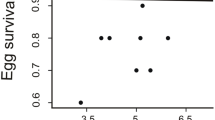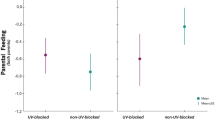Abstract
Carotenoid pigments have attracted much interest in behavioural and evolutionary ecology because of their dual function in immune physiology and as color signals. In vertebrates, carotenoids must ultimately be obtained from the diet, and the mechanisms and magnitude of this environmental dependence are central for understanding carotenoid signal functions and evolution. In the present cross-fostering experiment with great tits Parus major, we investigate pre- and postnatal parental effects (egg yolk carotenoids, parental coloration) on nestling size and carotenoid coloration, using HPLC analysis of egg yolk carotenoids, and a reflectance-based measure of ‘chroma’ that reflects the plumage pigment concentration. Both rearing environment and origin influenced offspring size and plumage chroma. Maternal allocation of carotenoids to eggs had a weak positive effect on nestling plumage chroma, whereas we found no prenatal maternal effects (egg size or yolk carotenoid concentration) on size. Nestling plumage chroma was also significantly predicted by the chroma of the rearing father, but not by the color of the rearing mother or either of the original (genetical) parents. Thus, both prenatal maternal effects and postnatal paternal effects influence the carotenoid-based plumage coloration of nestling great tits. Future studies will reveal if parental effects have long-term consequences for plumage development and associated fitness components.

Similar content being viewed by others
References
Andersson S, Pryke SR, Örnborg J, Lawes MJ, Andersson M (2002) Multiple receivers, multiple ornaments, and a trade-off between agonistic and epigamic signaling in a widowbird. Am Nat 160:683–691
Andersson S, Uller T, Löhmus M, Sundström F (2004) Effects of egg yolk testosterone on growth and immunity in a precocial bird. J Evol Biol 17:501–505
Andersson S, Prager M (2006) Quantifying colors. In: Hill GE, McGraw KJ (eds) Bird coloration, Vol 1. Mechanisms and measurements. Harvard Univ. Press, Cambridge, MA (USA), pp 41–89
Bendich A (1989) Carotenoids and the immune response. J Nutr 119:112–115
Blount JD, Houston DC, Møller AP (2000) Why egg yolk is yellow. Trends Ecol Evol 15:47–49
Boileau TWM, Moore AC, Erdman JW (1999) Carotenoids and vitamin A. In: Papas AM (eds) Antioxidant status, diet, nutrition, and health. CRC, New York, pp 133–157
Bortolotti GR, Tella JL, Forero MG, Dawson RD, Negro JJ (2000) Genetics, local environment and health as factors influencing plasma carotenoids in wild American kestrels (Falco sparverius). Proc R Soc Lond B 267:1433–1438
Brush AH (1990) Metabolism of carotenoid pigments in birds. FASEB J 4:2969–2977
Burley N (1988) The differential-allocation hypothesis. Am Nat 132:611–628
Cramp S, Perrins CM (1993) The birds of the western Palearctic, vol 8. Oxford University, Oxford
Dufva R, Allander K (1995) Intraspecific variation in plumage coloration reflects immune-response in Great Tit (Parus major) Males. Funct Ecol 9:785–789
Eeva T, Lehikoinen E, Ronka M (1998) Air pollution fades the plumage of the Great Tit. Funct Ecol 12:607–612
Fitze PS, Kölliker M, Richner H (2003a) Effects of common origin and common environment on nestling plumage coloration in the great tit (Parus major). Evolution 57:144–150
Fitze PS, Tschirren B, Richner H (2003b) Carotenoid-based colour expression is determined early in nestling life. Oecologia 137:148–152
Goodwin TW (1986) Metabolism, nutrition, and function of carotenoids. Annu Rev Nutr 6:274–297
Haq AU, Bailey CA, Chinnah A (1996) Effect of beta-carotene, canthaxanthin, lutein, and vitamin E on neonatal immunity of chicks when supplemented in the broiler breeder diets. Poult Sci 75:1092–1097
Hill GE, Inouye CY, Montgomerie R (2002) Dietary carotenoids predict plumage coloration in wild house finches. Proc R Soc Lond B 269:1119–1124
Hõrak P, Vellau H, Ots I, Møller AP (2000) Growth conditions affect carotenoid-based plumage coloration of great tit nestlings. Naturwissenschaften 87:460-464
Hõrak P, Ots I, Vellau H, Spottiswoode C, Møller AP (2001) Carotenoid-based plumage coloration reflects hemoparasite infection and local survival in breeding great tits. Oecologia 126:166–173
Johnsen A, Delhey K, Andersson SA, Kempenaers B (2003) Plumage colour in nestling blue tits: sexual dichromatism, condition dependence and genetic effects. Proc R Soc Lond B 270:1263–1270
Kilner R (1997) Mouth colour is a reliable signal of need in begging canary nestlings. Proc R Soc Lond Ser B 264:963–968
Kirkpatrick M, Lande R (1989) The evolution of maternal characters. Evolution 43:485–503
Kluijver HN (1950) Daily routines of the great tit, Parus m. major L. Ardea 38:99–135
Kowalczyk K, Daiss J, Halpern J, Roth TF (1985) Quantification of maternal-fetal IgG transport to the chicken. Immunology 54:755–762
Krebs EA, Putland DA (2004) Chic chicks: the evolution of chick ornamentation in rails. Behav Ecol 15:946–951
Krinsky NI (2001) Carotenoids as antioxidants. Nutrition 17:815–817
Limbourg T, Mateman AC, Andersson S, Lessells CM (2004) Female blue tits adjust parental effort to manipulated male UV attractiveness. Proc R Soc Lond B 271:1903–1908
Linville SU, Breitwisch R, Schilling AJ (1998) Plumage brightness as an indicator of parental care in northern cardinals. Anim Behav 55:119–127
Littel RC, Milliken GA, Stroup WW, Wolfinger RD (2000) SAS system for mixed models. SAS Institute, Cary, North Carolina
Lyon BE, Eadie JM, Hamilton LD (1994) Parental choice selects for ornamental plumage in coot chicks. Nature 371:240–243
McGraw KJ, Hill GE (2000) Differential effects of endoparasitism on the expression of carotenoid- and melanin-based ornamental coloration. Proc R Soc Lond B 267:1525–1531
McGraw KJ, Beebee MD, Hill GE, Parker RS (2003) Lutein-based plumage coloration in songbirds is a consequence of selective pigment incorporation into feathers. Comp Biochem Physiol 135B:689–696
McGraw KJ, Adkins-Regan E, Parker RS (2005) Maternally derived carotenoid pigments affect offspring survival, sex ratio, and sexual attractiveness in a colourful songbird. Naturwissenschaften 92:375–380
Mousseau TA, Fox CW (1998) The adaptive significance of maternal effects. Trends Ecol Evol 13:403–407
Nys Y (2000) Dietary carotenoids and egg yolk coloration—a review. Arch Geflugelkunde 64:45–54
Partali V, Liaaenjensen S, Slagsvold T, Lifjeld JT (1987) Carotenoids in food-chain studies. 2. The food-chain of Parus spp. monitored by carotenoid analysis. Comp Biochem Physiol 87B:885–888
Pryke SR, Andersson S (2005) Experimental evidence for female choice and energetic costs of male tail elongation in red-collared widowbirds. Biol J Linn Soc 86:35–43
Quinn G, Keough M (2002) Experimental design and data analysis for biologists. Cambridge University, Cambridge
Saino N, Ninni P, Calza S, Martinelli R, De Bernardi F, Møller AP (2000) Better red than dead: carotenoid-based mouth coloration reveals infection in barn swallow nestlings. Proc R Soc Lond B 267:57–61
Saino N, Bertacche V, Ferrari RP, Martinelli R, Møller AP, Stradi R (2002) Carotenoid concentration in barn swallow eggs is influenced by laying order, maternal infection and paternal ornamentation. Proc R Soc Lond B 269:1729–1733
Saino N, Ferrari R, Romano M, Martinelli R, Møller AP (2003) Experimental manipulation of egg carotenoids affects immunity of barn swallow nestlings. Proc R Soc Lond B 270:2485–2489
Saks L, McGraw K, Hõrak P (2003) How feather colour reflects its carotenoid content. Funct Ecol 17:555–561
Schwabl H (1993) Yolk is a source of maternal testosterone for developing birds. Proc Natl Acad Sci USA 90:11446–11450
Schwabl H (1996) Environment modifies the testosterone levels of a female bird and its eggs. J Exp Zool 276:157–163
Senar JC, Figuerola J, Pascual J (2002) Brighter yellow blue tits make better parents. Proc R Soc Lond B 269:257–261
Sheldon BC (2000) Differential allocation: tests, mechanisms and implications. Trends Ecol Evol 15:397–402
Slagsvold T, Lifjeld JT (1985) Variation in plumage coloration of the great tit Parus major in relation to habitat, season, and food. J Zool Lond 206A:321–328
Snijders TAB, Bosker RJ (1999) Multilevel analysis. An introduction to basic and advanced multilevel modeling. SAGE, London, pp 102
Stradi R (1998) The colour of flight: carotenoids in bird plumage. Gruppo editoriale informatico, Milan
Surai PF, Speake BK (1998) Distribution of carotenoids from the yolk to the tissues of the chick embryo. J Nutr Biochem 9:645–651
Surai PF, Ionov IA, Kuchmistova EF, Noble RC, Speake BK (1998) The relationship between the levels of alpha-tocopherol and carotenoids in the maternal feed, yolk and neonatal tissues: comparison between the chicken, turkey, duck and goose. J Sci Food Agric 76:593–598
Surai P (2002) Natural antioxidants in avian nutrition and reproduction. Nottingham University Press, Nottingham, pp 129–200
Thompson CW, Hillgarth N, Leu M, McClure HE (1997) High parasite load in house finches (Carpodacus mexicanus) is correlated with reduced expression of a sexually selected trait. Am Nat 149:270–294
Tschirren B, Fitze PS, Richner H (2003) Proximate mechanisms of variation in the carotenoid-based plumage coloration of nestling great tits (Parus major L.). J Evol Biol 16:91–100
Tschirren B, Fitze PS, Richner H (2005) Carotenoid-based nestling colouration and parental favouritism in the great tit. Oecologia 143:477–482
von Schantz TS, Bensch S, Grahn M, Hasselquist D, Wittzell H (1999) Good genes, oxidative stress and condition-dependent sexual signals. Proc R Soc Lond B 266:1–12
West-Eberhard MJ (2003) Developmental plasticity and evolution. Oxford University, New York
Wolf JB, Brodie ED III, Cheverud JM, Moore AJ, Wade MJ (1998) Evolutionary consequences of indirect genetic effects. Trends Ecol Evol 13:64–69
Acknowledgements
We thank Mats Hulander, Nina Jansson, and Uno Unger for assistance in the field and Maria von Post for help in the laboratory. Three anonymous reviewers provided valuable comments on a previous draft of this paper. Roche Vitamins, (Basel, Switzerland) generously provided us with all carotenoid standards. The work was supported by Lars Hiertas Minne (to C. I.), Wenner-Gren Foundations (to T. U.) and The Swedish Research Council for Environment, Agricultural Sciences and Spatial Planning (to S. A.). The study was conducted in full compliance with Swedish laws and regulation, including ethical permit from Centrala Försökdjursnämnden, CFN.
Author information
Authors and Affiliations
Corresponding author
Additional information
Communicated by K. McGraw
Rights and permissions
About this article
Cite this article
Isaksson, C., Uller, T. & Andersson, S. Parental effects on carotenoid-based plumage coloration in nestling great tits, Parus major . Behav Ecol Sociobiol 60, 556–562 (2006). https://doi.org/10.1007/s00265-006-0200-6
Received:
Revised:
Accepted:
Published:
Issue Date:
DOI: https://doi.org/10.1007/s00265-006-0200-6




